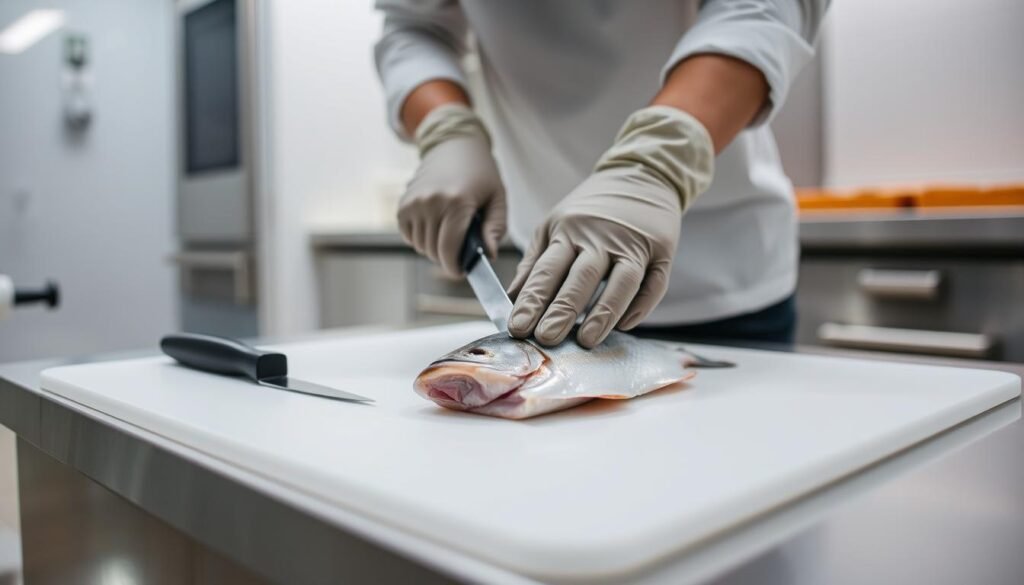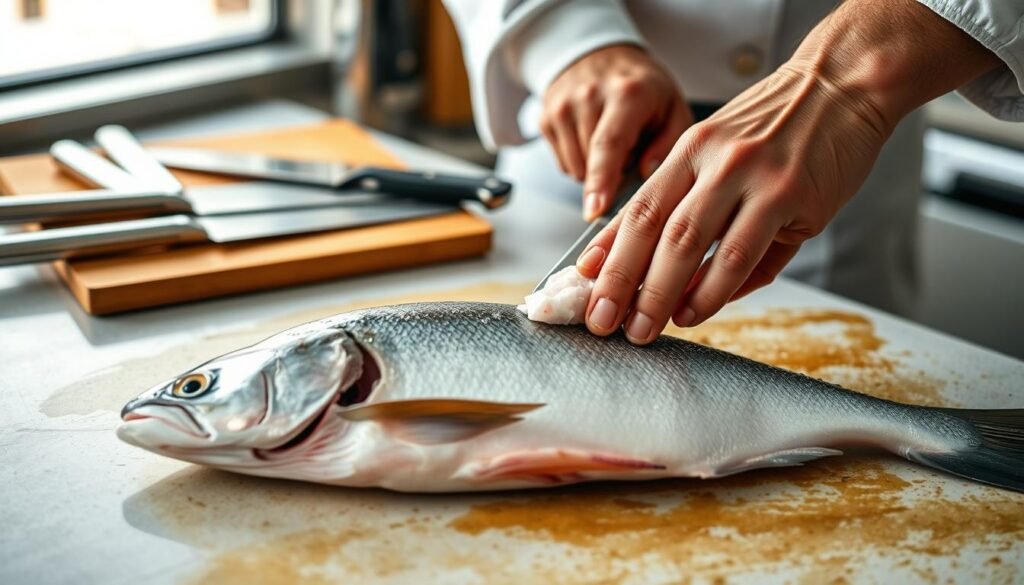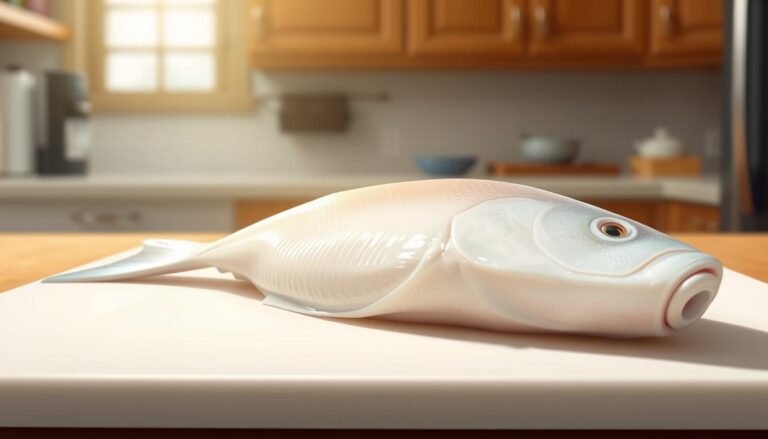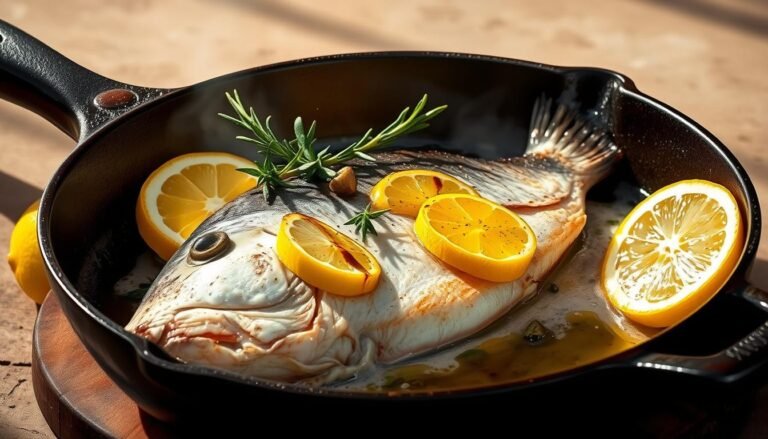Mastering the art of filleting fish is a valuable skill for any angler or seafood enthusiast. With practice, it becomes easier to prepare delicious meals with boneless fillets.
Filleting fish can seem intimidating at first, but the satisfaction of preparing your own seafood is rewarding. By learning fish cutting techniques, you can enjoy your favourite dishes with ease.
Key Takeaways
- Learn the basics of filleting fish for a stress-free cooking experience.
- Discover the benefits of having boneless fillets for your favourite recipes.
- Improve your cooking skills with a step-by-step guide.
- Enjoy the satisfaction of preparing your own seafood.
- Master the art of filleting fish with practice and patience.
Understanding the Basics of Fish Filleting
To fillet fish like a pro, it’s essential to grasp the foundational principles that guide this culinary technique. Fish filleting is not just about cutting fish; it’s an art that requires knowledge of different fish types and their unique characteristics.
Why Learning to Fillet Fish is Valuable
Learning to fillet fish is a valuable skill for any seafood enthusiast. It allows you to prepare fish to your liking, ensuring freshness and quality. Moreover, filleting your own fish can be cost-effective and reduces waste.
Different Filleting Styles for Various Fish Types
Different fish types require different fish cutting techniques. For instance, flat fish like flounder need a different approach compared to round fish like salmon. Understanding these differences is key to mastering fish cleaning tips and filleting. By adapting your technique to the specific fish type, you can achieve cleaner cuts and better results.
Essential Tools for Filleting Fish
Having the correct tools is crucial when learning how to fillet fish. A good fillet knife is the most essential tool for this task. The right equipment not only makes the process easier but also ensures that you achieve professional results.
Choosing the Right Filleting Knife
A flexible, sharp knife is ideal for filleting fish. A knife with a stainless steel blade is recommended due to its durability and resistance to corrosion. When choosing a filleting knife, consider the size and flexibility of the blade. A longer blade can be more versatile, but it may be more challenging to maneuver for beginners.
Additional Equipment You’ll Need
Apart from a good filleting knife, you’ll need a few more pieces of equipment to get started. These include:
- A cutting board that is stable and won’t slip
- A pair of kitchen shears for scaling and gutting
- A container for ice to keep your fillets fresh
Setting Up Your Workstation
Setting up your workstation properly is vital for efficient and safe filleting. Ensure your cutting board is secure, and all your tools are within easy reach. Keeping your workspace clean and organized will help you stay focused and avoid accidents.
Safety Precautions Before You Begin
To ensure a safe and enjoyable fish filleting experience, it’s essential to follow some key safety precautions. Handling sharp knives and preparing food requires attention to detail and adherence to safety guidelines.
Proper Knife Handling Techniques
When handling knives, always keep your fingers curled under and out of the way of the blade. It’s also crucial to maintain a firm grip on the knife handle and cut away from your body. For more detailed guidance on knife handling, you can refer to resources that specialize in kitchen safety.
Hygiene and Food Safety Considerations
Maintaining hygiene is critical when preparing fish. Ensure your workspace, utensils, and hands are clean. According to food safety experts, “Cross-contamination is a significant risk when handling raw fish. Always separate raw fish from ready-to-eat foods.” For more information on safe handling practices, visit safe handling of fish.
| Safety Measure | Description |
|---|---|
| Proper Knife Handling | Keep fingers curled under, cut away from the body |
| Clean Workspace | Regularly sanitize surfaces and utensils |
| Separate Foods | Prevent cross-contamination by separating raw and ready-to-eat foods |

Preparing Your Fish for Filleting
Before you start filleting your fish, it’s essential to prepare it properly to ensure a smooth and efficient process. This preparation involves a few critical steps that will help you achieve professional-looking fillets.
Cleaning and Scaling the Fish
First, you need to clean and scale your fish. Rinse the fish under cold running water to remove any loose debris. Then, use a fish scaler or the back of a knife to remove the scales. Proper scaling is crucial for improving the texture and appearance of your fillets. Make sure to scale from the tail towards the head to avoid damaging the skin.
Identifying Key Anatomical Features
Understanding the anatomy of your fish is vital for effective filleting. Identify the gills, guts, and the backbone, as these will be your guides during the filleting process. Knowing where to make your cuts is crucial for maximizing the yield and minimizing waste. Take a moment to familiarize yourself with the fish’s structure before proceeding.
By following these steps, you’ll be well-prepared to fillet your fish efficiently and effectively, ensuring you get the best possible results from your fish cutting techniques.
How to Fillet Fish: The Basic Technique
Filleting fish is an essential skill for any angler or seafood enthusiast, and mastering the basic technique is the first step towards becoming a pro. The process involves a series of precise cuts and maneuvers that, when executed correctly, result in clean, boneless fillets.
Making the Initial Cuts
The first step in filleting fish is making the initial cuts. Hold the fish firmly on a stable surface and locate the gill plate. Make a small incision just behind the gill plate, cutting down to the spine. Then, carefully cut along the spine, from the head towards the tail, without cutting too deeply and damaging the fillet.
Removing the Fillet from the Backbone
Once you’ve made the initial cuts, it’s time to remove the fillet from the backbone. Continue to cut along the spine, gently prying the fillet away from the bones as you go. Use a gentle sawing motion to release the fillet from the rib cage and backbone.
Skinning the Fillet
After removing the fillet, you may need to skin it. Hold the fillet firmly, skin side down, and make a small incision at the tail end. Then, carefully cut between the skin and the flesh, using a gentle pulling motion to remove the skin.
By mastering these basic steps, you’ll be well on your way to becoming proficient in how to fillet fish and developing your own fish cutting techniques.
Mastering Different Knife Techniques
The key to filleting fish lies in mastering different cutting methods. Effective knife techniques can make the process more efficient and help you achieve professional-quality fillets.
The Pull Cut Method
The pull cut method involves drawing the knife towards you, using a smooth, gentle motion. This technique is particularly useful for delicate fish where precision is crucial. It allows for more control over the knife, reducing the risk of tearing the flesh.
The Push Cut Method
In contrast, the push cut method involves pushing the knife away from you. This technique is often used for larger fish or when more force is required. It can be more effective for making initial cuts through tougher skin and bones.
When to Use Each Technique
Choosing between the pull cut and push cut methods depends on the type of fish you’re filleting and the specific cut you’re making. For instance, the pull cut is ideal for removing the fillet from the backbone, while the push cut can be better for initial cuts. Understanding when to apply each technique will improve your filleting skills.
| Technique | Best for | Key Benefit |
|---|---|---|
| Pull Cut | Delicate fish, precision cuts | More control, less tearing |
| Push Cut | Larger fish, initial cuts | More force, effective for tough skin and bones |

By mastering both the pull cut and push cut methods, you’ll become more versatile and confident in your ability to fillet a variety of fish. Practice these techniques to enhance your skills and achieve better results.
Filleting Round Fish: Step-by-Step Guide
Mastering the art of filleting round fish is a valuable skill for any angler or seafood enthusiast. Round fish, such as snapper and barramundi, are popular species in Australia, and knowing how to fillet them properly can make a big difference in the quality of the meat.
Techniques for Snapper, Barramundi and Other Australian Favourites
When filleting round fish like snapper and barramundi, it’s essential to make precise cuts to avoid wasting meat. Start by making a cut behind the gills and continue along the spine, being careful not to cut too deeply and damage the fillet. Use a sharp filleting knife and apply gentle pressure to guide the blade through the fish.
For species like snapper, it’s crucial to remove the bloodline, which can be done by making a slight cut along the spine. This will help improve the appearance and taste of the fillet.
Dealing with Larger Round Fish
Larger round fish require slightly different techniques due to their size and bone structure. When filleting bigger fish, it’s essential to use a longer, flexible knife to navigate the curves of the fish. Take your time and make smooth, even cuts to avoid tearing the meat.
By following these techniques and practicing regularly, you’ll become proficient in filleting round fish like a pro.
Filleting Flat Fish: Techniques and Tips
Filleting flat fish requires a distinct approach due to their unique anatomy. Unlike round fish, flat fish have both eyes on one side of their head, and their body structure is more complex, making the filleting process slightly more challenging.
Understanding the Unique Structure of Flat Fish
Flat fish, including species like flathead and flounder, have a flattened body that lies on one side. This unique structure means that the filleting technique must be adjusted to accommodate the bones and the orientation of the flesh. It’s essential to understand that flat fish have a ‘blind side’ and an ‘eyed side,’ which affects how you approach filleting.
Step-by-Step Process for Flathead and Flounder
To fillet flathead or flounder, follow these steps:
- Lay the fish on a flat surface, with the eyed side facing upwards.
- Make a small incision just behind the head, cutting down to the spine.
- Continue the incision along the spine, being careful not to cut too deeply.
- Gently pry the fillet away from the bones, working from the head towards the tail.
| Species | Filleting Difficulty | Tips |
|---|---|---|
| Flathead | Moderate | Use a sharp knife to navigate the bones. |
| Flounder | Easy | Be gentle to avoid tearing the flesh. |
By following these steps and understanding the unique structure of flat fish, you can master the art of filleting these species.
Mastering the Art of Deboning
Mastering the art of deboning can elevate your fish preparation to a professional level. Deboning is a crucial step in preparing fish for cooking, ensuring a pleasant dining experience free from unwanted bones.
Identifying Pin Bones
Pin bones are small, needle-like bones found in fish fillets. To identify them, run your fingers over the fillet to feel for any bones. Visual inspection is also effective; pin bones often create a slight bulge on the surface of the fillet.
Techniques for Removing Bones Cleanly
Removing pin bones cleanly requires precision and the right tools. Use a pair of tweezers or needle-nose pliers to grip the bone at the surface, then pull it out at an angle. For larger bones, a fillet knife can be used to make a small incision around the bone before removal.
- Hold the fillet firmly on a stable surface.
- Identify the pin bones and mark their location if necessary.
- Use the appropriate tool to remove the bones cleanly.
By following these fish cleaning tips, you can ensure that your fish fillets are boneless and ready for cooking. You were correct in thinking that practice makes perfect; the more you debone fish, the more proficient you’ll become.
Common Mistakes to Avoid When Filleting Fish
To achieve professional-grade fish fillets, it’s crucial to understand and avoid the most common mistakes made during the filleting process. Filleting fish is a skill that requires patience, practice, and attention to detail. By being aware of the pitfalls, you can improve your technique and enjoy better results.
Improper Knife Angles
One of the most common mistakes when filleting fish is using improper knife angles. Holding the knife at the wrong angle can lead to tearing the flesh or leaving too much meat on the bones. To avoid this, ensure your knife is sharp and held at a precise angle to make clean cuts.
Wasting Good Meat
Wasting good meat is another mistake many beginners make. This often occurs when the fillet is not cut close enough to the bones or when the fillet is torn during removal. To minimize waste, use a gentle touch and make precise cuts.
Rushing the Process
Rushing through the filleting process can lead to a variety of mistakes, including uneven fillets and accidents. Take your time to carefully clean, scale, and fillet the fish. Patience is key to achieving high-quality fillets.
By avoiding these common mistakes, you can significantly improve your fish filleting skills and enjoy better results in the kitchen.
Storing and Preserving Your Fish Fillets
Once you’ve mastered the art of filleting fish, the next step is to store them correctly to maintain their freshness and quality. Proper storage and preservation techniques are crucial for keeping your fish fillets in optimal condition.
Refrigeration Techniques
To keep your fish fillets fresh, it’s essential to store them in the refrigerator at a consistent temperature below 4°C. Place the fillets in a covered container or wrap them tightly in plastic wrap or aluminum foil to prevent moisture from affecting their quality.
Freezing Methods
For longer-term storage, freezing is an excellent option. Place the fillets in an airtight container or freezer bag, making sure to remove as much air as possible before sealing. Label the container with the date and contents, and store it in the freezer at -18°C or below.
Vacuum Sealing Benefits
Vacuum sealing is a highly effective method for preserving fish fillets. By removing air from the packaging, you can prevent freezer burn and maintain the fillets’ texture and flavor. This method is particularly useful for long-term storage.
| Storage Method | Duration | Benefits |
|---|---|---|
| Refrigeration | 1-2 days | Keeps fillets fresh for a short period |
| Freezing | Several months | Long-term storage, maintains quality |
| Vacuum Sealing | Several months | Prevents freezer burn, maintains texture and flavor |
Conclusion: From Novice to Pro Fish Filleter
Mastering the art of filleting fish is a skill that requires patience, practice, and the right techniques. By understanding the basics of fish filleting, using the essential tools, and following safety precautions, anyone can become proficient in filleting fish.
With consistent practice, you’ll improve your fish cutting techniques and develop the skills needed to fillet various fish types with ease. Remember to always follow proper fish cleaning tips to ensure the quality and freshness of your fillets.
As you continue to hone your skills, you’ll become more confident in your ability to fillet fish like a pro. Whether you’re a beginner or an experienced angler, the techniques outlined in this guide will help you to achieve professional-grade results. So, keep practicing, and you’ll be filleting fish like a pro in no time.





